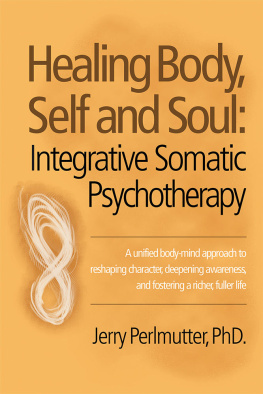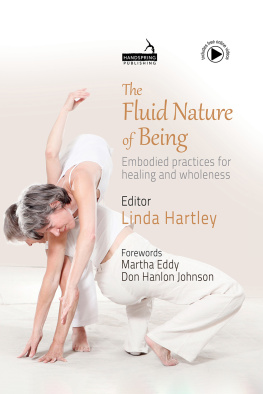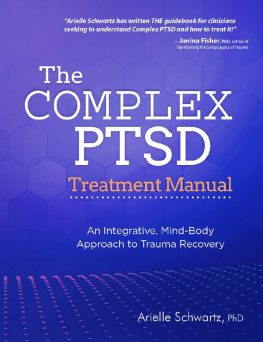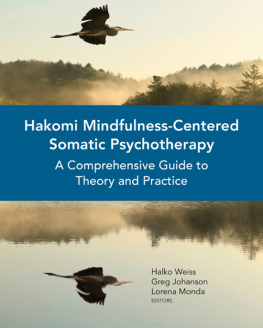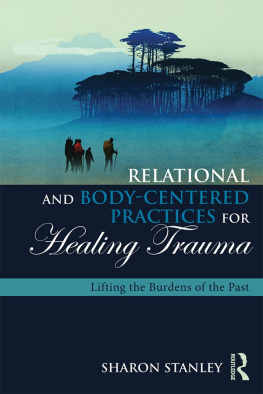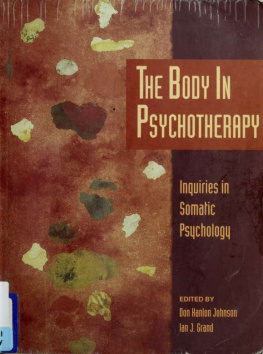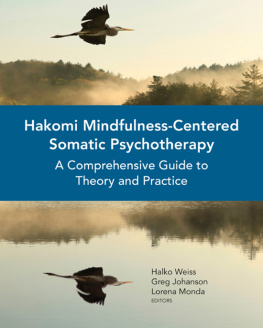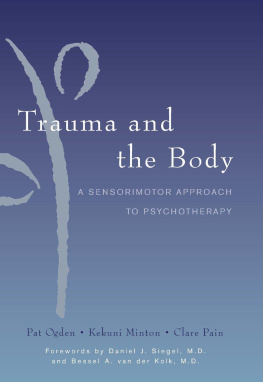Healing Body,
Self and Soul
Integrative Somatic
Psychotherapy
Jerry Perlmutter, PhD

Copyright 2015 Jerry Perlmutter, PhD.
All rights reserved. No part of this book may be used or reproduced by any means, graphic, electronic, or mechanical, including photocopying, recording, taping or by any information storage retrieval system without the written permission of the publisher except in the case of brief quotations embodied in critical articles and reviews.
Balboa Press
A Division of Hay House
1663 Liberty Drive
Bloomington, IN 47403
www.balboapress.com
1 (877) 407-4847
Because of the dynamic nature of the Internet, any web addresses or links contained in this book may have changed since publication and may no longer be valid. The views expressed in this work are solely those of the author and do not necessarily reflect the views of the publisher, and the publisher hereby disclaims any responsibility for them.
The author of this book does not dispense medical advice or prescribe the use of any technique as a form of treatment for physical, emotional, or medical problems without the advice of a physician, either directly or indirectly. The intent of the author is only to offer information of a general nature to help you in your quest for emotional and spiritual well-being. In the event you use any of the information in this book for yourself, which is your constitutional right, the author and the publisher assume no responsibility for your actions.
Any people depicted in stock imagery provided by Thinkstock are models, and such images are being used for illustrative purposes only.
Certain stock imagery Thinkstock.
Library of Congress Control Number: 2015910112
ISBN: 978-1-5043-3592-8 (sc)
ISBN: 978-1-5043-3591-1 (hc)
ISBN: 978-1-5043-3593-5 (e)
Balboa Press rev. date: 09/18/2015
CONTENTS
I would like to acknowledge some of the people who played important roles in my professional development.
John Collier, anthropology professor at the City College of New York, taught me reverence and respect for the ways of all people, all cultures.
Clark Moustakos at the Merrill-Palmer Institute in Detroit was my first client-centered psychotherapy supervisor as I worked with children. I later had client-centered teachers at the house that Carl Rogers built, the University of Chicagos Counseling & Psychotherapy Center, where I took coursework in conducting psychotherapy and more supervision as I worked with children. From both of these experiences I learned to be empathic, and to respect my patients capacities to participate in their own healing and development.
Carl Whitaker , Professor at the University of Wisconsin, modeled utilizing all of self as a psychotherapist, letting go of depending on theory, and floating on a raft of informed intuition.
I am in debt to the NTL Institute for Applied Behavioral Science. There I learned to move from theory to practice fluidly, effectively and congruently.
I am also in debt to Alan Richardson, who gave me my initial training in body psychotherapy. He was trained by Malcolm Brown, who at that time was more committed to body psychotherapy, as defined by Wilhelm Reich and Alexander Lowen.
I appreciate those who worked as staff with me over the thirty-six years that we did Soul Workshops, one-week workshops, which incorporated bodywork (soft and deep tissue massage), exercise, spontaneous expressive movement, art, yoga and meditation. These workshops were used as less expensive ways to do therapy intensives, and they were very rich and deep experiences for participants. The staff included Joyce Weir, Murry Perlmutter, Marianne Johnson, Leighton Clark and Barbara Cargill.
Persons connected to the Midwest Institute for Somatic Psychotherapy in Illinois have given me support in the development of Integrative Somatic Psychotherapy over the years, especially: Leighton Clark, Bonnie Summers, Larry Carroll, Jeannie Kokes, Carole Veronesi, Christie Ahrens, Bridget Penney, Nancy Voss, Steve Treacy and Carolyn Faivre. They were Board Members of this non-profit professional organization.
To my professional colleagues: Leighton Clark, Marianne Johnson, Bill Waldner, Phil Metres and Darrell Nicks, I give them my thanks for their help.
To two key persons who helped me to generate this book with the quality it has: the artist, Scott Wills, who developed the cover of the book and all of its illustrations; to Mitchell Kupferberg who edited the manuscript.
I appreciate the patients I have accompanied on courageous journeys of self-discovery and transformation over 41 years. We have learned from each other.
I have been a teacher or a trainer all of my adult life. I started at age 18 when I taught new employees how to convert gas refrigerators so that they used natural gas instead of the older bottle gas. I have gone on to teach professionals in all kinds of settings.
In an organizational change context, I have trained managers and line workers. I have trained boards of non-profit organizations. I have taught nurses, social workers and psychologists to do group psychotherapy. I have taught group and consulting skills to psychologists, social workers and business school graduate students. These constitute only a sample of my training work.
I have received excellent body psychotherapy treatment from Malcolm and Kathryn Brown. I have been inspired by the writings of Alexander Lowen from the start of my career. My experiences giving and receiving body psychotherapy have led me to develop my own ways of working in this modality. I have been asked to train body psychotherapists, and this was pivotal in leading me to write and document my approach. In order to teach, I had to make explicit what I had been doing implicitly and intuitively, so that I could communicate this to trainees.
For more than thirty years I have used systems theory in my Organizational Development practice.
All of my conceptualization about individuals, groups and organizations entail the fundamental use of the systems approach. When I started to practice, the systems approach entailed how work organizations transform information to create value. Body psychotherapy has led me to expand my view of systems in that they also transform energy , and this too is crucial to the quality of their functioning and to the quality of their outputs. This latter approach has expanded my knowledge of humanity and enormously increased the ways in which I intervene when I do body psychotherapy.
Immediately, it comes to me that I want to briefly report the full swath of the development of this manuscript. I am drawn into sharing from my starting as a patient in body psychotherapy. A colleague of mine, for whom I felt a lot of respect, suddenly announced to me that he had started receiving body psychotherapy and really liked it. On the spot, I decided that I would try it, too. And, from the start, it felt right for me too; I had a gut feeling of it being a good fit for me. This is not a reflection that the therapy was fun, entertaining or a romp. I did work on painful, traumatic experiences and events that provoked my anger and rage. But working on these events felt right to me; I had to do this to reach for my authentic self. I wanted this connection very much.
After a few years of work, my therapist told me he was starting a training group, and he invited me to join. I was enthralled with taking the training. I developed a physical exercise program for myself, to help me do the work well. Then I made a decision to stay in body therapy for years, till I had certainty that I had worked myself as much as I could. I owed this to my future patients so that I did not lay my personal (unfinished) issues on them. I was in therapy for nine to ten years. My first therapist was a male. And then I had therapy with a woman. I also had an intensive with a married couple. Each of these therapist situations helped me to work different areas of my life. I also attended a training workshop with Alexander Lowen and had some therapy sessions with him while I was on a sabbatical from my teaching position. I attended training sessions with well-known body therapists whenever I could. For example, I invited Ron Kurtz to take over a session of the training group that I attended, with our trainers approval.
Next page
